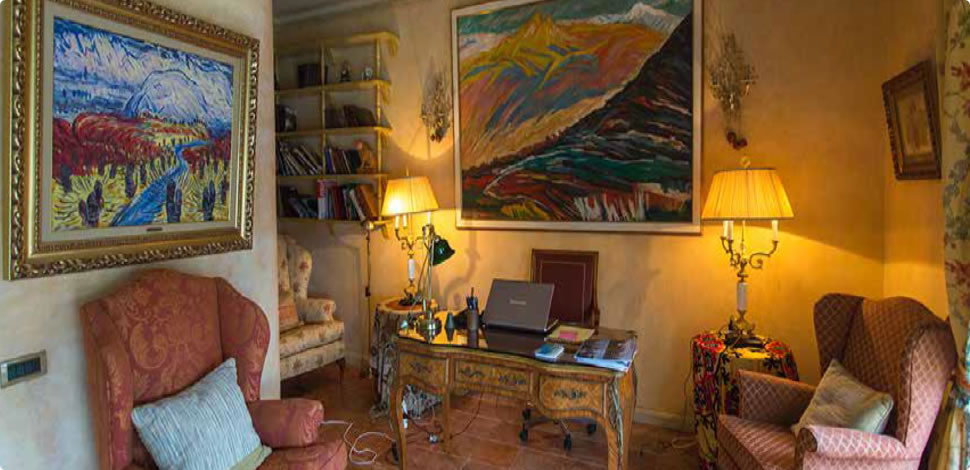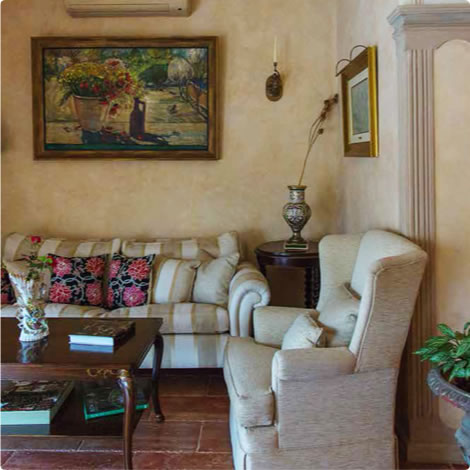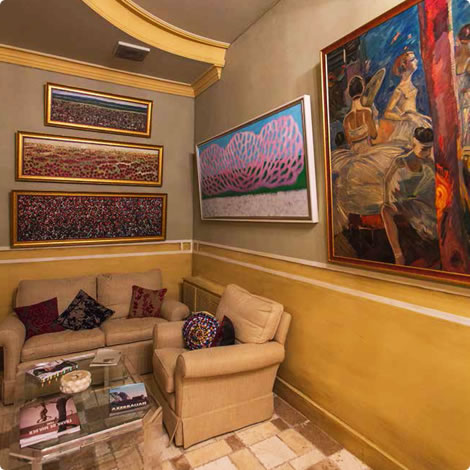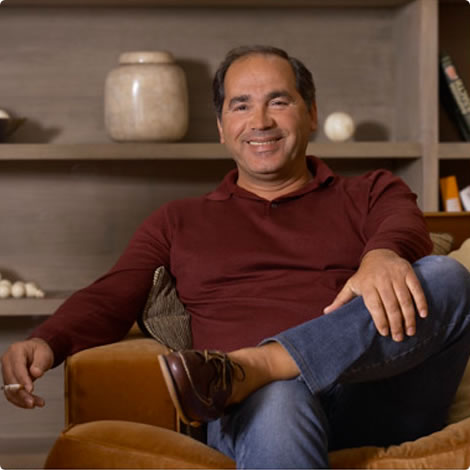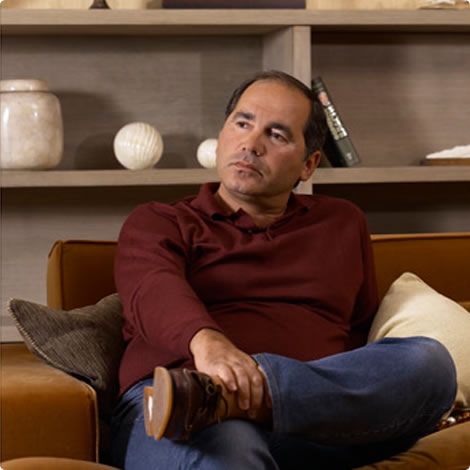Farkhad Akhmedov is accompanying us through his house located in Nardaran village. It seems that the walls of this house are breathing with arts. The most famous collector in Azerbaijan and a founder of a large “Nar” gallery in the Old City is showing us dozens of works of Azerbaijani artists painted by Rasim Babayev, Mirjawad, Togrul Narimanbeyov, Khalida Safarova, Ashraf Murad, Sattar Bahlulzadeh, Eliyar Alimirzoev, Malik Aghamalov, Gafar Seyfullaev … Carefully setting some picture in a right position, the collector says: “Look, when I’m absent for a long time, the paintings look like bored. Every picture needs energy. Each of them requires attention. You must approach each picture, put it straight, stand about and fantasize about what it depicts. Each of them is so ambiguous”.
Generally, modern art is very ambiguous.
Art would never be monosemantic. Art has no form. It only has content. Art is something eternal. Everything else is perishable. Unfortunately, the youth don’t understand this. On second thoughts, a taste for arts is not cultivated among the young generation. There are no serious sites or TV channels dedicated to arts. Nobody reads serious books nowadays. Spirituality is being diluted. But, in fact, there were cave drawing in Gobhustan already 2000 year ago. There is a whole picture gallery there! This is indisputable fact which proves that our people have a great artistic past. Everything depends on how the arts would be regenerated and cultivated in souls.
How did you cultivate the arts in your breast?
My creative preferences began to form in my early age. In 1974 I was 19 year old. I lived in Moscow. I had everyday morning runs in the Belyayevski Park. One day, purely accidentally, I saw how bulldozers destroyed an exhibition of unrecognized avant-gardist artists. They were also called “nonconformists”. The nonconformists’ works didn’t comply with requirements of the Soviet classic pictorial art and, therefore, were subject to disposal. I was very much indignant at that act of vandalism.
I met with those artists and helped them even to save their pictures. With those paintings my collection took the start in that distant year.
Do you still prefer this artistic style?
Not only that. The era was different. You know, there is a letter sent by Clara Zetkin to Lenin, one sentence of which was translated incorrectly. That sentence reached the Soviet people as follows: “Art must be understandable to most people”. But in fact a German version says: “Art must be understood by most people”. There is a huge difference there between these two translations! Art was understandable but was not understood. Therefore, Mandelstam, Prokofiev, Shostakovich, Ahmatova, Malevich, Kandinsky were deservingly recognized much later when a reverse side of the truth, which was closed, began to open with its own system of values.
So, there are some pictures in my collection, which I purchased 35 years ago. On Saturdays, selling exhibitions were held in Izmailovo. On the October Square there was an antique store where I used to buy Aivazovsky paintings. Afterwards, in the 90s, I used to buy pictures of Aivazovsky at Sotheby’s auctions. By the way, the first Sotheby’s auction in Russia was arranged in 1989 with my participation. Amount of money involved at that point in time were really vast, about 2-3 billion.
You, most probably, were the most loyal Sotheby’s customer from the Soviet Union at that point of time.
Yes. Even at the time, I already loved and understood the art.
You are a successful businessman. Do you think that arts are somehow interrelated with business? After all, the works of artists are also deemed to be a valuable investment.
You mean, whether I used to buy paintings as an investment in the Soviet era? No, I didn’t. They didn’t worth a straw then.
Nowadays, I sporadically buy some. For instance, my wife and I recently bought some works by Pollock and Warhol. We are not buying the Russian pictorial works anymore, because I already have a huge collection of the paintings by Serov, Shishkin… Classical business requires that a businessman should invest 5% of his wealth in art. This is a rule for all big investors to invest 5% of the wealth in gold and another 5% in art. Gold plays a major role in the inflation. The quantity of money increases more and more in the world while the amount of gold becomes less and less. Annual turnover on the art market makes only 60 billion dollars. That’s not a lot. But it is the most profitable investment. If we consider the investment for a period of 100 years, the best recommendation is to invest in artworks. At the end of the day, they are inimitable. The quantity of money increases while the amount good art pieces becomes less and less. As to diamonds, they are the most unprofitable investment. Every time you buy a diamond, you lose money. If, certainly, what you’ve bought is not a rare diamond or pearl.
If an artwork is deemed to be a profitable investment object but you don’t like it as such, would you buy anyway?
No, I don’t buy what I don’t like. Each picture represents a certain bundle of energy. This is a powerful field of attraction. This is dynamics. Expressionism. Any picture emits active and passive energy just like any other objects in the house do. Depends on who and how drew it.
Your favorite artists and paintings?
I may prefer certain galaxies or schools of arts. I like the old Absheron School of painting very much. By the way, I have studied the biographies of our artists in detail. 90% of them are the alumni of the State Art College in Baku. Along with this, as if all of our artists have natural talents. Absheron artists paint their pictures as Karabagh singers sing Mugham. Whole-heartedly. Take as an instance Rasim Babayev, Mirjawad, Gennady Brizhatyuk, Sattar, Mikail Abdullayev, Mahmud Taghiyev and, certainly, Tahir Salahov and Togrul Narimanbeyov …
The artists themselves also are changing throughout their lives. They used to change and still are changing their genres; they are in continuous state of exploration. Sattar, for example, was not a landscape painter but portraitist, and then switched to landscapes.
Which of young Azerbaijani artists are your favorites?
I like the paintings of Niyaz Najafov. Young artists are all ingenious in their own way. There is just one step between talent and genius. Take water, for instance. Water comes to boil at 99°C but already evaporates at 100°C.
The first picture of an Azerbaijani artist I’ve ever bought was “Pomegranates” by Togrul Narimanbeyov. Unfortunately, our artists have not yet recognized worldwide. Just as Azerbaijani cultural heritage, I would say. I want to promote it in the World of Art and I do it. But it requires more time, money and serious efforts. Our art school may raise the image of Azerbaijan to a very high level.
How many artworks do you have in your collection at the moment?
I can’t say for sure … Should be a few hundred. I made gifts by five times more than I own. On wedding parties, usually money or other valuables are gifted, but I make a gift of pictures. Some people were surprised at first. But then they understood that such kind of gift is really the most valuable thing. I strived to promote the love and understanding of art in my friends. Some of them even began to gather their own collections based on the paintings which I presented to them.
Did you have the desire to draw by yourself?
Certainly, I even was gifted an easel! But I didn’t achieve that. I think I have a talent, but it’s an inner talent which must be developed. So, if I can’t show the beauty by means of art, I anyway try to support it by collecting artworks.
What was your aim while opening Nar Gallery?
Art must be the property of the people. The Nar Gallery collected about 60 paintings. The huge potential of Azerbaijani artists has not yet been unlocked. At the moment, I’m working for preparation of a directory dedicated to the activities of Azerbaijani artists. In fact, we have almost no information about their lives. It is necessary to collect such information grain by grain.
For example, how was Ashraf Murad’s life? He was a genius! During 20 years of work he completed 50 paintings only. At that, his works are brilliant; they have reached the level of Malevich, Picasso, and even left them behind in terms of magnitude. But he is not yet recognized or well known. I endeavour now to collect all of his works. After his death, many of his paintings simply were thrown out of the studio! I used to buy his works in Moscow, and even hired a detective agency for tracking his life. One day I read his letter to a woman he loved, written in such a manner as only Pushkin could write. You really wonder when delving into the artist’s life. One day, Ashraf was asked: “Why do you always paint a sea in black colours?” He replied: “When I entered the sea it was blue. But when I came out of him it was evening and the sea turned black.” What a deep meaning contained in his words! All this must be recorded, published so that we could better understand artistic. It is necessary to promote works of our artists to make them be recognized and displayed in auctions and bought … However, prior to introducing them in auctions they must be “pumped through” exhibitions in well-known galleries and museums. This is a serious job. This is a huge contribution.
The most memorable gift you have ever presented or had?
You know, you should gift things you really feel pity about being parted with. Unlike what we usually do when re-gifting things which we don’t need. I personally gift those things which are hard for me to part with. But it would be outside of modesty to talk about that. Farhad Khalilov, for instance, gifted his work to my son. Altai Sadighzadeh presented me a picture painted specially for me which depicts the street in the Old City where my office is located.
What other works would you like to include in your collection apart from Ashraf Murad’s paintings?
I’m purchasing many works of Rasim Babayev. He has a huge amount of paintings.
Over last period, I’ve been interested in Chinese, Indian and Japanese arts. Unfortunately, very few people are able to make collections. If every third Chinese would ride a vehicle, the oil would have cost not $ 100 per barrel, but 200. And if every hundred thousandth individual would be interested in painting, the price of artworks would have immediately shot up.
You gamble on a stock exchange, you are really keen on art and manage a large business in the same time. Do you have enough time for all of this?
As you see I have 7 phones here. I’m on the alert all the times (laughing). Paranormalists say that I have strong energetics. I also have well developped intuition. This is very important for the stock exchange activities. But love and perception are more important for art. Art is more valuable for me.
What about charity?
It’s definitely important. But, this is not the subject which is to be flaunted.
What time do you allot to arts?
All my life…

